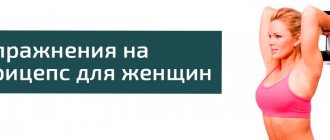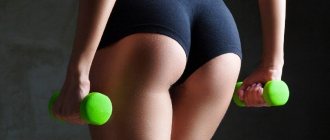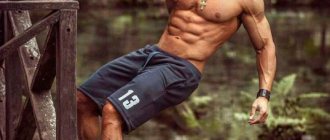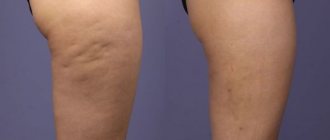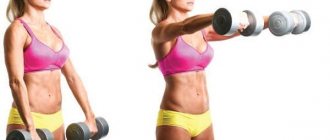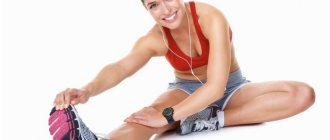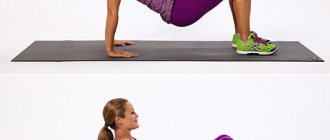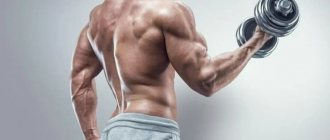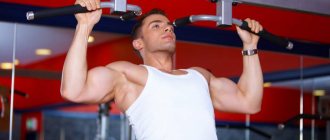The triceps forms the relief and bulk of the shoulder; it is also an extensor of the arm. Therefore, if you want to improve your athletic performance or just pump up your arms and create relief, triceps exercises should definitely be included in your training program. Let's look at how to pump up triceps at home.
- Triceps: photo, structure and functions
- How to train triceps at home: Triceps pumping exercises at home
- French bench press with weights
- Video: Triceps pumping: French dumbbell bench press, nuances of execution
- Reverse push-ups
- Video: Reverse push-ups from a bench, different difficulty options
- Seated one-arm dumbbell French press
- Video: One-arm French dumbbell press in a seated position
- Bent over arm extension with dumbbell
- Video: How to properly perform bent over dumbbell extensions
- Close grip push-ups
- Video: A woman can also pump up her triceps with this exercise: Narrow-grip push-ups
- Triceps exercise program
- Video: How to pump up triceps at home
- Practical tips on how to pump up your triceps
Triceps: photo, structure and functions
The triceps muscle occupies the entire back of the shoulder and consists of three parts:
- lateral or short head, also called the anterior triceps;
- long head or posterior tuft;
- medial or middle head, otherwise - internal bundle.
Most
Functions of the triceps:
- movement of the arm from front to back, mainly due to the long head of the triceps;
- extension of the arm at the elbow;
- bringing the arm to the body.
The triceps muscles make up 2/3 of all shoulder muscles, so training the triceps is necessary for the harmonious development of the arms.
Features of the structure of the triceps
The triceps consists of three bundles of muscles that narrow closer to the elbow and connect into one tendon. Thanks to this structure, the main role of this muscle group is performed - extension at the elbow. Generally speaking, any exercise to a certain extent and with varying loads always affects all 3 bundles. The main reason is the different attachment points on top.
Typically, difficulties arise with pumping the long head of the triceps, since it is attached to the shoulder blade. This means that for maximum load, the elbow must be pulled back during the exercise. When under load, the middle fascicle of the muscle begins to work first, while an increase in the weight of the projectile forces the outer (lateral) part of the muscle to engage in work, and only in extreme cases does the long triceps fascicle come to the rescue. But it is the long head that is the most massive part of the triceps, and therefore it is necessary to try to develop it.
Since we are more interested in the long bundle of muscle, we will consider the main factors that make it work:
- exercises should include moving your arm back or even needing to raise your arm up (example: French press).
- The higher the working weight of the projectile, the more the long part of the triceps is loaded.
- It is important to keep your elbows close to your body.
- It is necessary to use the shoulder joint in the exercises. To constantly load it, the French press is often used, which is performed lying down, keeping your arms in the starting position at an angle to your head.
- It is better to hold the exercise with your palms up when performing exercises, otherwise more load will be transferred to the outer triceps.
It is important not to lift the weight with your entire body during shoulder-load training. If the physically chosen weight is not suitable, then jerking can only provoke injury. If you can’t complete the next approach, choose a lighter weight.
We advise you to start your training with basic exercises, giving your full effort when performing them (bench press with a narrow grip or dips). Then, during an isolated exercise, the triceps will already be warmed up and there will be no need to use weights that can cause injury. Now let’s move on to a description of the basic techniques that solve the question of how to pump up triceps.
How to train triceps at home: Triceps pumping exercises at home
Lack of opportunity or desire to go to the gym should not become an obstacle to training. Moreover, you can always use, for example, water bottles as weights, and a bench in some exercises can be replaced by the floor or a regular chair.
French bench press with weights
An excellent isolated load on the triceps will be given by the French dumbbell bench press. You can perform the exercise not only with a barbell, but also with dumbbells. At home, you can lie on the floor (on a rug). If you don't have dumbbells on hand, plastic bottles filled with water or sand will do. If you have not done this exercise before, use light weights, as the French press puts more stress on the elbow joint. The exercise is basic and good for pumping up your triceps.
Technique:
- Take a horizontal position, take weights in your hands.
- Raise the dumbbells above you. Straight arms are tilted towards the head at a slight angle.
- As you inhale, bend your elbows, bringing the dumbbells to approximately ear level. The shoulders remain motionless.
- As you exhale, extend your arms to the starting position, straightening them completely. Make sure your shoulders are secure. Do not spread your arms; the distance between the dumbbells in the starting position should be 20–25 centimeters.
- Do 10-12 reps in 2-3 sets.
The further your arms move behind your head, the greater the load.
Video: Triceps pumping: French dumbbell bench press, nuances of execution
Reverse push-ups
To perform reverse push-ups at home, you can use a chair or any low furniture that you can lean on. The lower the support, the more load the triceps will receive. This is a basic exercise and you can vary the load. Beginners and women will make the exercise easier for themselves by helping with the process with their feet. Trained athletes can perform reverse push-ups and further increase their weight with the help of a heavy backpack.
The technique is shown in the photo below:
- Find something high, such as a chair. Turn your back to him and lower yourself down, resting your hands on the chair slightly wider than shoulder-width apart.
- Feet firmly on the floor. Straight legs will provide more load than bent knees.
- Inhale and slowly lower yourself down, bending your elbows. Calculate your strength; you don’t need to sink all the way to the floor if you feel that you won’t be able to get up later.
- As you exhale, rise up by straightening your arms.
- If your goal is the fastest possible muscle growth, then the negative phase of the exercise should take 2-3 times longer than the positive phase. That is, you need to go down slower than you go up.
- Do 8-12 reps in 2-3 sets.
Bent legs make it easier to perform.
If you have shoulder problems, perform reverse push-ups only with your doctor's approval.
Video: Reverse push-ups from a bench, different difficulty options
Seated one-arm dumbbell French press
The good thing about this exercise is that it can be performed by people of any skill level. You can start doing it with the smallest weights of 1–2 kg. This type of bench press is ideal for doing at home; it does not require much space, and almost any household item that is convenient to hold with one hand can serve as a weight.
Technique:
- Sit up straight, place your feet on the floor shoulder-width apart, the position should be stable.
- Take the weight in one hand and lift it above your head, perpendicular to the floor.
- The position of the working hand is correct when the palm faces forward and the little finger faces the ceiling. The elbow should not be turned either forward or backward.
- As you inhale, bend your working arm at the elbow and smoothly lower the dumbbell behind your head until your forearm touches your biceps.
- As you exhale, straighten your arm and return the dumbbell to the top, it is very important that the shoulder does not move. If you can't lock your shoulders, use a lighter weight.
- Do 10-15 reps in 2-3 sets.
1
Video: One-arm French dumbbell press in a seated position
Bent over arm extension with dumbbell
This exercise works the triceps in isolation without damaging your shoulders or back. Bent-over arm extensions are suitable for beginners and can be used to begin preparing for the transition to more demanding exercises.
Technique:
- Take a suitable weight in your working hand. To support your feet, you can use a chair, leaning on it with one knee, or you can simply stand on the floor, for stability, pushing forward the leg opposite your working hand.
- If using a chair, use your non-working hand to grasp the edge of the chair for balance. Place your knee on the chair. If you work without a chair, bend your knees slightly.
- Tilt your straight body forward until it is diagonal with the floor. The stronger the slope, the greater the load will be.
- Raise your working arm to the starting position: the shoulder is parallel to the body, the elbow joint is bent at a right angle.
- As you exhale, gently lift the dumbbell, straightening your arm at the elbow until it is straight.
- As you inhale, bend your arm and return it to its original position.
- Do 8-12 reps in 2-3 sets for each arm.
The shoulder is fixed, the arm moves in an arc.
Video: How to properly perform bent over dumbbell extensions
Close grip push-ups
Technique:
- Take a lying position, the weight should fall on straight arms and toes. Hands should be at a distance narrower than shoulder width, legs and body should form a single straight line.
- The palms can be turned with the fingers towards each other at an angle of no more than 30 degrees.
- Bend your elbows and inhale as you lower yourself down. Don't lie on the floor, keep tension in your arms.
- As you exhale, straighten your arms and rise up.
- Perform 10–15 reps in 2–3 sets.
1
Beginners can change the emphasis by standing on their knees rather than on their feet, and advanced athletes can make push-ups more challenging by wearing a weighted backpack.
Video: A woman can also pump up her triceps with this exercise: Narrow-grip push-ups
Is it possible to pump up big triceps at home?
Of course, at home there is not such a variety of strength training equipment as in the fitness room. But! What is triceps? This is an arm extensor. Based on this function in the body, exercises for the development of this muscle are formed. To make your triceps bigger and stronger, you need to extend your arms with weights. That's all. Therefore, classic triceps exercises at home, performed with your own weight or with dumbbells, will be no less effective.
The main thing is not where the training takes place, but how it goes. Exercise with dedication and regularly: only constant training can achieve good results. Don't quit your studies halfway! Very often, people, without receiving a quick return, quit training after a month. Or they just start being lazy, and their time ends up being wasted. A little persistence and will - and very soon you will understand how to properly work this muscle, and also feel real movement towards the goal.
Triceps exercise program
How to get outstanding triceps? Need a training program. Triceps exceeds biceps not only in volume, but also in strength - 2-3 times. Therefore, downloading it is a little easier. If your triceps are not developed, then when you start training, focus on a period of several months.
Training goals vary:
- increase in muscle mass;
- development of muscle relief;
- increased muscle strength;
- increase in impact force;
- development of endurance.
You need to work on each goal for 8–12 weeks. The deadline may not be limited.
Depending on the goal, you need to build your training:
- To grow muscle mass, you need to work with weights, performing fewer repetitions in one approach: 6-10 repetitions in 3-4 approaches with heavy weight.
- To develop muscle relief, you need to bring the percentage of body fat to a certain level; interval and cardio training are suitable for this. The number of repetitions in exercises is 12–15.
- To increase muscle strength, you can use static exercises, when you don’t just lift weights, but hold in the final position for 5-10 seconds.
- To increase striking power, you need to perform plyometric exercises. For example, push-ups become plyometric if, when pushing off the floor, you “bounce” with your arms, that is, you lift off the floor so that only your legs remain below.
- To develop endurance, you need to perform as many repetitions as possible in one approach.
Training plan for pumping triceps, perform 12 repetitions in 3 approaches:
- French bench press.
- Seated one-arm French press, work each arm.
- Bent over arm extensions with dumbbells.
- Close grip push-ups.
To develop mass, use medium weights. But you need to remember that to use scales you need to be physically fit.
Before completing the program, you need to strengthen your joints and tone your triceps. To do this, perform all the described exercises with the lightest weights and concentrate primarily on technique. If your muscles are not at all prepared, then reverse push-ups from a chair or even from the floor will help with this perfectly.
It is recommended to switch to heavier weights no earlier than after 1.5 months. To achieve results, you need to include such a program in your training twice a week.
Video: How to pump up triceps at home
Useful tips
Basic rules for working out the triceps muscle at home:
- The training complex should include both basic and isolating triceps exercises;
- When it comes to working with weights, there are several important nuances: firstly, you should not chase a lot of weight - 2-kilogram dumbbells are suitable for women, and 5-kilogram dumbbells for men. Secondly, if sports equipment is not available, it can be replaced with plastic bottles filled with water.
Choosing the optimal weight of dumbbells for women
- Triceps exercises at home should be selected based on your training goals. So, if we are talking about quickly and efficiently increasing the mass of the triceps muscle, you should make sure that each lesson includes as many variations on the theme of isolated training as possible. Simple multi-repetition basic exercises (for example, push-ups from a bench) will help you create the necessary relief.
- The triceps muscle is pumped no more than 2-3 times a week in the process of working on the “top”.
Practical tips on how to pump up your triceps
To pump up your triceps correctly, you need to follow certain rules:
- Muscles must be properly nourished. There are no universal nutritional standards. The general norms for gaining muscle mass with a weight of 70 kg are as follows: 260–300 grams of carbohydrates and 180–200 grams of protein and 65–75 grams of fat per day.
- Muscles need to rest and recover. It is recommended to train triceps no more than twice a week. If your muscles are sore, it will be more beneficial to postpone training until they recover.
- Before working with weights, warm up well, do not start training right away, this is dangerous not only for the triceps, but also for the arm joints. If you experience joint pain, do not continue exercising and be prepared that the pain may not go away on its own and you may need to see a doctor.
- Focus on basic exercises: French press, reverse and narrow push-ups with weights. They will help your arms gain weight, and additional exercises are needed more in order to diversify the load.
- During the exercise, do not straighten your arm completely. This is fraught with joint injury and reduces the useful load on the triceps. A straight arm in triceps exercises is always a very slightly bent arm.
- Perform flexion and extension of your arms to the full amplitude; if you lower your arm, then lower it all the way. Prefer full range of motion over reps. Frequent repetition increases the risk of joint injuries.
- There should be no jerking or sudden movements in the exercises, especially when working with additional weight. Muscles and joints develop better with a smooth, stable load. If your goal is striking power, then sudden movements are possible in the exercises, but they are part of proper technique.
- You can vary the load on different triceps heads simply by rotating your hand. By rotating your arms in the joints, you can load different parts of the triceps and diversify your workouts.
- If you use heavy weights, try pyramid sets. This is a type of training where you increase the weight and decrease the number of repetitions with each set. Start with 15 reps and medium to light weights, the second set will be 12 reps, and the third will be 8-10 reps and the heaviest weight for you. Calculate the load correctly; even the heaviest weight should not cause pain in the joints.
Developed triceps can be obtained not only in the gym, but also at home. For training, you will need knowledge of several basic exercises, improvised weights and a chair. To keep your pumping in full swing, work on your triceps twice a week, stick to the correct technique and be patient - you're on the right track.
Exercises
The internal triceps press with a narrow grip is excellent. An important point in this case is the location of the elbows: during the exercise they should be tucked towards the body. It may not be possible to lift a lot of weight this way, but it is indispensable in developing proportional and pleasing to the eye triceps.
It is worth noting that the work on the internal triceps bundle will be grueling. In order to fully use the internal triceps, you must first exhaust the resource of the medial and then the external bundles. Thus, for systematic movement towards the desired result, the load should remain high, but not excessive. Pumping up the internal triceps is a long and complex process; the main thing is to follow the technique, otherwise you can get injured.
The next exercise for the inner triceps is the French EZ-bar press from behind the head or upside down. It is advisable to take it on just after the previous one, when the glycogen in the muscle is already sufficiently exhausted. When starting to perform the French press, remember: working with heavy weight in this case is inappropriate and is often fraught with injury.
Finally, push-ups on parallel bars with a narrow grip and extensions on a vertical block are no less effective. However, you cannot do without isolated exercises on the inner head of the triceps. The most optimal during one training session lasting about an hour is the following scheme: one basic and several isolated exercises.
